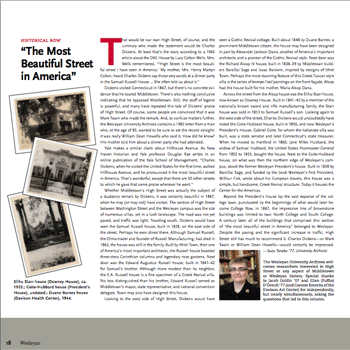HISTORICAL ROW: THE MOST BEAUTIFUL STREET IN AMERICA
 That would be our own High Street, of course, and the luminary who made the statement would be Charles Dickens. At least that’s the story according to a 1942 article about the DKE House by Lucy Colton Wells. Mrs. Wells remembered, “‘High Street is the most beautiful street I have seen in America.’ My mother, Mrs. Henry Martyn Colton, heard Charles Dickens say those very words at a dinner party in the Samuel Russell House … She often told us about it.”
That would be our own High Street, of course, and the luminary who made the statement would be Charles Dickens. At least that’s the story according to a 1942 article about the DKE House by Lucy Colton Wells. Mrs. Wells remembered, “‘High Street is the most beautiful street I have seen in America.’ My mother, Mrs. Henry Martyn Colton, heard Charles Dickens say those very words at a dinner party in the Samuel Russell House … She often told us about it.”
Dickens visited Connecticut in 1867, but there’s no concrete evidence that he toured Middletown. There’s also nothing conclusive indicating that he bypassed Middletown. Still, the stuff of legend is powerful, and many have repeated this tale of Dickens’ praise of High Street. Of course, some people are convinced that it was Mark Twain who made the remark. And, to confuse matters further, the Wesleyan University Archives contains a 1982 letter from a man who, at the age of 85, wanted to be sure to set the record straight: it was really William Dean Howells who said it. How did he know? His mother told him about a dinner party she had attended.
Yale makes a similar claim about Hillhouse Avenue. As New Haven historian and Yale professor Douglas Rae writes in an online publication of the Yale School of Management, “Charles Dickens, when he visited the United States for the first time, walked Hillhouse Avenue, and he pronounced it the most beautiful street in America. That’s wonderful, except that there are 50 other streets to which he gave that same praise wherever he went.”
Whether Middletown’s High Street was actually the subject of a laudatory remark by Dickens, it was certainly beautiful in 1867, when he may (or may not) have visited. The section of High Street between Washington Street and the Wesleyan campus was the site of numerous villas, set in a lush landscape. The road was not yet paved, and traffic was light. Traveling south, Dickens would have seen the Samuel Russell house, built in 1828, on the east side of the street. Perhaps he even dined there. Although Samuel Russell, the China trader and founder of Russell Manufacturing, had died in 1862, the house was still in the family. Built by Ithiel Town, then one of America’s most important architects, the Russell house boasted three-story Corinthian columns and legendary rose gardens. Next door was the Edward Augustus Russell house, built in 1841–42 for Samuel’s brother. Although more modest than its neighbor, the E.A. Russell house is a fine specimen of a Greek Revival villa. No less distinguished than his brother, Edward Russell served as Middletown’s mayor, state representative, and national convention delegate. Town may also have designed this house.
Looking to the west side of High Street, Dickens would have seen a Gothic Revival cottage. Built about 1848 by Duane Barnes, a prominent Middletown citizen, the house may have been designed in part by Alexander Jackson Davis, another of America’s important architects and a pioneer of the Gothic Revival style. Next door was the Richard Alsop IV house, built in 1838–39 by Middletown builders Barzillai Sage and Isaac Baldwin, inspired by designs of Ithiel Town. Perhaps the most stunning feature of this Greek-Tuscan style villa is the series of trompe l’oeil paintings on the front facade. Alsop had the house built for his mother, Maria Alsop Dana.
Across the street from the Alsop house was the Elihu Starr house, now known as Downey House. Built in 1841–42 by a member of the nationally known sword and rifle manufacturing family, the Starr house was sold in 1853 to Samuel Russell’s son. Looking again to the west side of the street, Charles Dickens would undoubtedly have noted the Coite-Hubbard house, built in 1856, and now Wesleyan’s President’s House. Gabriel Coite, for whom the Italianate villa was built, was a state senator and later Connecticut’s state treasurer. When he moved to Hartford in 1860, Jane Miles Hubbard, the widow of Samuel Hubbard, the United States Postmaster General from 1852 to 1853, bought the house. Next to the Coite-Hubbard house, on what was then the northern edge of Wesleyan’s campus, stood the former Wesleyan President’s house. Built in 1838 by Barzillai Sage, and funded by the book Wesleyan’s first President, Willbur Fisk, wrote about his European travels, this house was a simple, but handsome, Greek Revival structure. Today it houses the Center for the Americas.
Beyond the President’s house lay the vast expanse of the college lawn, punctuated by the beginnings of what would later become College Row. In 1867, the impressive line of brownstone buildings was limited to two: North College and South College. A century later, all of the buildings that comprised this section of “the most beautiful street in America” belonged to Wesleyan. Despite the paving and the significant increase in traffic, High Street still has much to recommend it. Charles Dickens—or Mark Twain or William Dean Howells—would certainly be impressed.
—Suzy Taraba ’77, University Archivist
The Wesleyan University Archives welcomes researchers interested in High Street or any aspect of Middletown or Wesleyan history. Special thanks to Jacob Goldin ’07 and Ellen (Puffin) D’Oench ’77 (and Curator Emerita of the Davison Art Center) for independently, but nearly simultaneously, asking the questions that led to this column.
